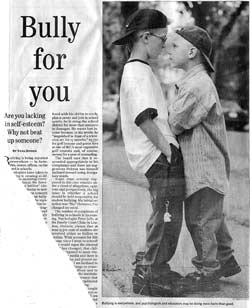


November 7, 2000
|
Bullying is being reported everywhere—in
factories, stores, offices, on the roads and in schools. Psychologists have taken to categorizing
it, creating 10 different classes including cyber-bullies (who
haunt the Internet) and “serial bullies” (described
in terms similar to serial killers). The biggest concern being
expressed is about bullying in schools, where the topic is gaining
national attention because experts, pointing to tragic events
in Littleton, Tabor and Ottawa, claim that seemingly trivial
bullying will lead to serious violence, including murder and
suicide. Last October, police in Halifax set up
a bullying hot line for students. This spring, British Columbia’s
education minister began promoting an anti-bullying video, and
many schools across Canada, including Vincent Massey Public
School in Ottawa, are initiating anti-bullying programs. A further
indicator of the growing concern can be found in the number
of books being published; at last count amazon.com listed more
than 120 titles. In reflecting on the 1950s when I was growing
up, I can’t recall fears about violence at school. Sure,
there were schoolyard fights—kids were knocked down, I
was hit by the occasional snowball. There was an “in-crowd,”
and those not part of it, like me, were snubbed. And sure, there
was name-calling; I used to be called “Tana-Banana.”
I wore glasses and got good grades, so I was sometimes teased.
But I can’t remember anything that couldn’t be shrugged
off. So, I wonder what it is that we’re
combating and how bullying has become such a massive problem.
I’ve been less than sympathetic as I’ve followed the
B.C. Human Rights Tribunal’s hearing of the complaints
of Azmi Dubran. Now 20, he alleges that he was harassed for
five years by other students who called him “queer”
and “faggot,” and that, on one occasion, his shirt
was set on fire. Claiming this interfered with his ability to
study, plan a career and join in school sports, he is suing
the school district for more than $100,000 in damages. He wants
lost income because, in his words, he “languished in front
of a television set for 13 months,” $3,750 for golf lessons
and green fees at one of B.C.’s most expensive golf courses
and, of course, money for a year of counseling. The board says that it responded appropriately
to his complaints and there are suggestions Dubran was himself
inclined toward using derogatory words. While what actually happened in this case
remains under a cloud of allegations, opinions and perspectives,
the big issue is whether a school should be held responsible
for student bullying. My initial reaction was “No.”
However, I’ve changed my mind. The number of complaints of bullying in
schools is increasing.
Psychologist Peter Jaffe, at the Family Court Clinic
in London, Ontario, claims that at least 15 per cent of students
are involved either as bullies or victims. What accounts for
this change since I went to school? Some would argue the external
world has changed, that children are exposed to more violence
in the media and there is less discipline and poorer supervision.
But I am inclined to attribute the change to something more
insidious and to point the finger at the narcissistic self-esteem
movement that has undermined our traditional approach to child-rearing. In classes, children are taught to repeat
and believe mantras like “I am Special” and “I
am Loveable.” Good grades and good behaviour have taken
a back seat as educators and parents have accepted that their
primary duty is to make kids feel good about themselves. The belief underlying this movement is
that low self-esteem is the cause of all problems. As psychologist
and self-esteem guru Nathaniel Branden, says: “I cannot
think of a single psychological problem— from anxiety and
depression to fear of intimacy or success, to spouse battery
and child molestation—that is not traceable to the problem
of poor self-esteem.” Therapists, educators and politicians,
accepting the popular view that low self-esteem gives rise to
aggression, have endorsed interventions and established treatment
programs to boost self-esteem. Students are being socially promoted
from one grade to the next to keep them with their peers and
the grading of achievement is discouraged so they won’t
feel bad. What is ignored in this feel-good approach
is the fact that bullying and violence are often carried out
by people with inflated egos rather than low self-esteem. Repeated
research findings have indicated that those who are aggressive—the
premeditated murderers, genocidal maniacs, gang leaders and
violent kids—do not suffer low self-esteem. “A recipe for violence,” as Martin
Seligman, past president of the American Psychological Associations
notes, “is a mean streak combined with an unwarranted sense
of self-worth.” And psychologist Roy Baumeister, who has
devoted his career to studying self-esteem, admits his surprise
in discovering that the self-esteem movement in schools may
be having the dangerous reverse effect of promoting bullying
and intimidation. “These practices,” Baumeister
says, “may cultivate inflated views of self and entitlements,
which constitute the dangerous form of high self-esteem.” Despite all the fluster over self-esteem,
surveys show that most North Americans already hold exaggerated
opinions of themselves, which may account for the rising problem
with bullying. Instead of counseling, most need training in
personal responsibility and self-control. Perhaps, the North Vancouver school district
should be held responsible for the bullying in the Dubran case,
not for its failure to intervene but for its implicit role in
creating bullies and their victims. If Dubran wins, and well he might, school
boards and education ministries across Canada may find themselves
paying for their mistake of encouraging uncritical self-worship,
upholding the students’ right to “feel good”
and embracing the foolish notion of “bully-proofed”
schools.
|
tanadineen.com
@ Dr.Tana
Dineen
1998-2003
by
Dr. Tana Dineen, special columnist,
The Ottawa Citizen
